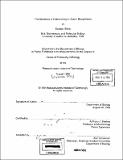The necessity of debranching in starch biosynthesis
Author(s)
Shaw, Eudean
DownloadFull printable version (5.157Mb)
Other Contributors
Massachusetts Institute of Technology. Dept. of Biology.
Advisor
Anthony J. Sinskey.
Terms of use
Metadata
Show full item recordAbstract
Although research in starch biosynthesis has been carried out since the 1940s, many issues remain unresolved. For example, the number of reactions in the pathway is still an open question. The biosynthesis of the starch granule from glucose-1-phosphate has long been considered to consist of three steps: 1. The synthesis of a glucosyl donor. 2. The formation of a-1,4 linkages to add the donor to a growing chain. 3. The hydrolysis of an a-1,4 linkage and subsequent formation of an a-1,6 linkage to introduce a branch point. Recently, a fourth step has been proposed in starch granule biosynthesis (Ball et al., 1996). This step involves the hydrolysis of a-1,6 linkages by the action of a debranching enzyme. Our study provides further evidence for the necessity of this debranching step through the analysis of the production of phytoglycogen and other novel polysaccharides in strains of Chlamydomonas reinhardtii lacking isoamylase activity. We demonstrate that granule-bound starch synthase I (GBSS I) is necessary to synthesize the minute amounts of novel insoluble amylose-like materials found in these mutants, and can do so in an unbound form. We also show that crystalline amylopectin is necessary for granule binding of GBSS I. (cont.) In addition, an understanding of phytoglycogen production is required for elucidating the role of debranching enzymes in starch biosynthesis. Since phytoglycogen has a higher percentage of branching than amylopectin, two explanations for the presence of phytoglycogen in plants have been proposed: 1. Plants producing phytoglycogen have a "phytoglycogen branching enzyme" that increases the number of branches in amylopectin to form phytoglycogen. 2. Plants producing phytoglycogen are lacking a debranching enzyme, implying that phytoglycogen is or comes from an intermediate in the amylopectin pathway. The results presented here suggest that the phytoglycogen branching activity that is clearly seen in a phytoglycogen-producing strain of C. reinhardtii also exists in the wild type strain but simply appears inhibited because the naturally present isoamylase interferes with the branching enzyme activity assay. Based on this, a model for starch biosynthesis that accounts for the conflicting data on phytoglycogen biosynthesis is identified.
Description
Thesis (Ph. D.)--Massachusetts Institute of Technology, Dept. of Biology, 1999. Includes bibliographical references (leaves 113-119).
Date issued
1999Department
Massachusetts Institute of Technology. Department of BiologyPublisher
Massachusetts Institute of Technology
Keywords
Biology.